University Statistics Homework: Sampling, Data Collection and Analysis
VerifiedAdded on 2023/04/23
|5
|758
|214
Homework Assignment
AI Summary
This statistics homework assignment delves into various sampling techniques and data collection methods. It begins with the application of Slovin's formula to determine sample sizes under different error margins. The assignment then explores simple random sampling and systematic sampling, provi...
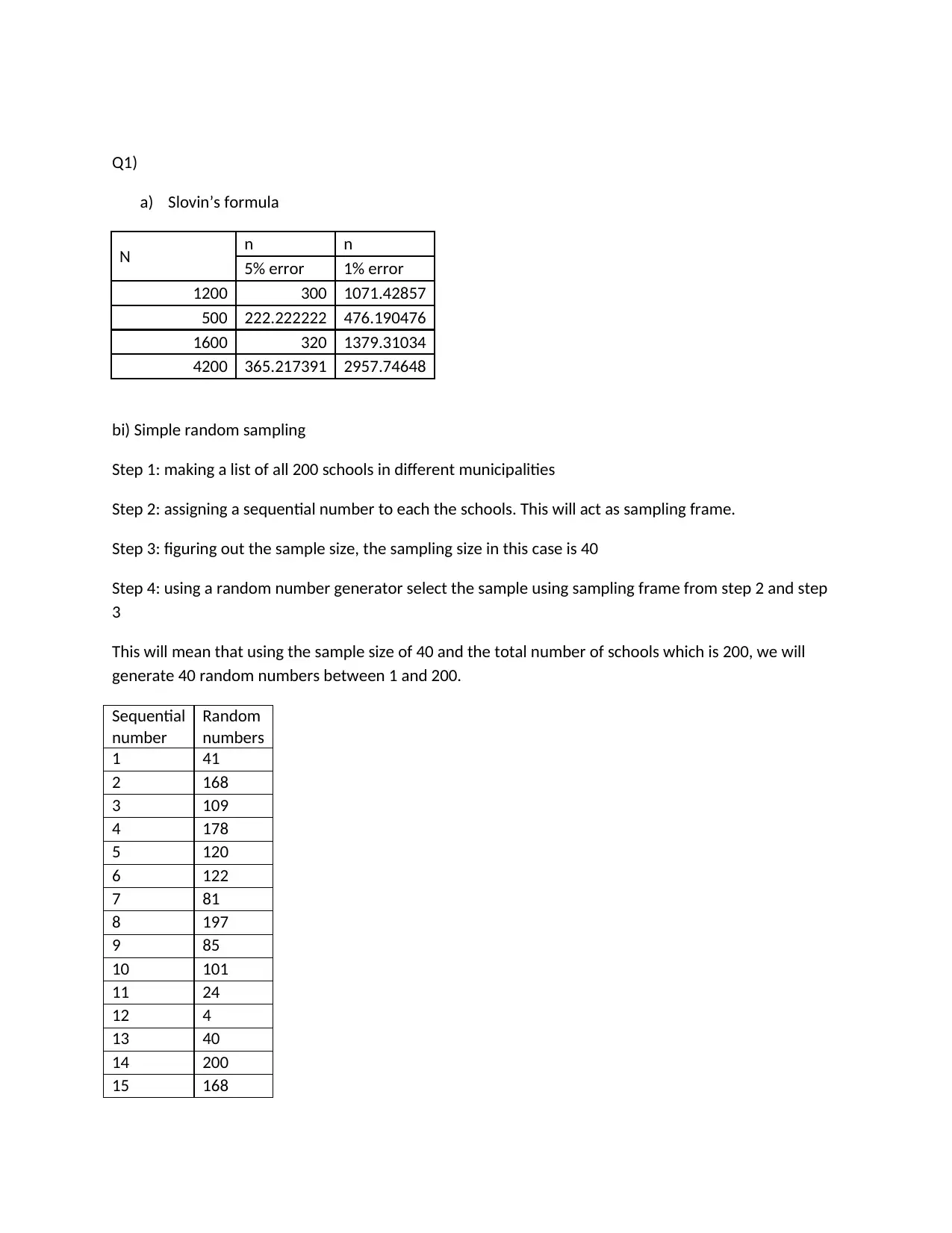
Q1)
a) Slovin’s formula
N n n
5% error 1% error
1200 300 1071.42857
500 222.222222 476.190476
1600 320 1379.31034
4200 365.217391 2957.74648
bi) Simple random sampling
Step 1: making a list of all 200 schools in different municipalities
Step 2: assigning a sequential number to each the schools. This will act as sampling frame.
Step 3: figuring out the sample size, the sampling size in this case is 40
Step 4: using a random number generator select the sample using sampling frame from step 2 and step
3
This will mean that using the sample size of 40 and the total number of schools which is 200, we will
generate 40 random numbers between 1 and 200.
Sequential
number
Random
numbers
1 41
2 168
3 109
4 178
5 120
6 122
7 81
8 197
9 85
10 101
11 24
12 4
13 40
14 200
15 168
a) Slovin’s formula
N n n
5% error 1% error
1200 300 1071.42857
500 222.222222 476.190476
1600 320 1379.31034
4200 365.217391 2957.74648
bi) Simple random sampling
Step 1: making a list of all 200 schools in different municipalities
Step 2: assigning a sequential number to each the schools. This will act as sampling frame.
Step 3: figuring out the sample size, the sampling size in this case is 40
Step 4: using a random number generator select the sample using sampling frame from step 2 and step
3
This will mean that using the sample size of 40 and the total number of schools which is 200, we will
generate 40 random numbers between 1 and 200.
Sequential
number
Random
numbers
1 41
2 168
3 109
4 178
5 120
6 122
7 81
8 197
9 85
10 101
11 24
12 4
13 40
14 200
15 168
Paraphrase This Document
Need a fresh take? Get an instant paraphrase of this document with our AI Paraphraser
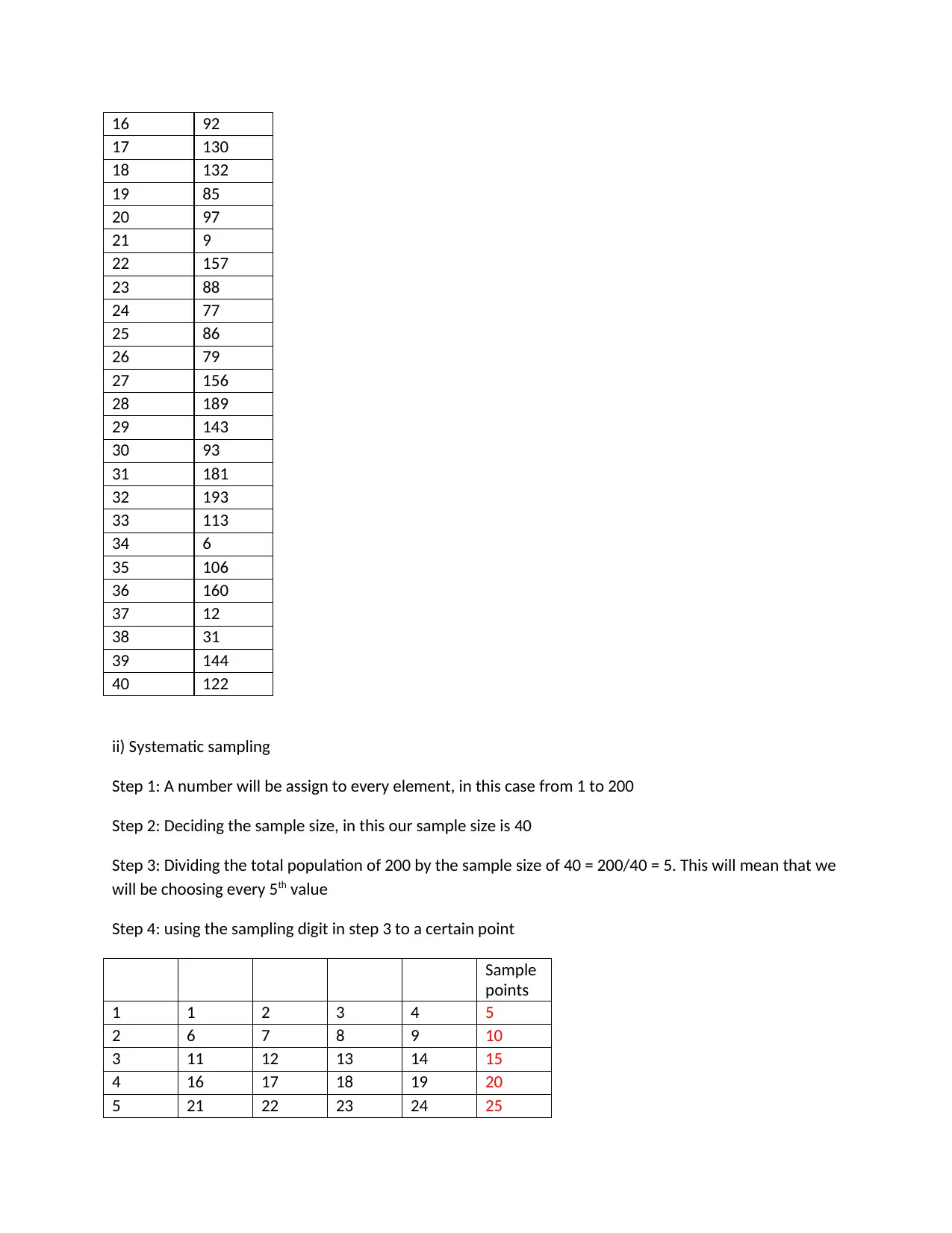
16 92
17 130
18 132
19 85
20 97
21 9
22 157
23 88
24 77
25 86
26 79
27 156
28 189
29 143
30 93
31 181
32 193
33 113
34 6
35 106
36 160
37 12
38 31
39 144
40 122
ii) Systematic sampling
Step 1: A number will be assign to every element, in this case from 1 to 200
Step 2: Deciding the sample size, in this our sample size is 40
Step 3: Dividing the total population of 200 by the sample size of 40 = 200/40 = 5. This will mean that we
will be choosing every 5th value
Step 4: using the sampling digit in step 3 to a certain point
Sample
points
1 1 2 3 4 5
2 6 7 8 9 10
3 11 12 13 14 15
4 16 17 18 19 20
5 21 22 23 24 25
17 130
18 132
19 85
20 97
21 9
22 157
23 88
24 77
25 86
26 79
27 156
28 189
29 143
30 93
31 181
32 193
33 113
34 6
35 106
36 160
37 12
38 31
39 144
40 122
ii) Systematic sampling
Step 1: A number will be assign to every element, in this case from 1 to 200
Step 2: Deciding the sample size, in this our sample size is 40
Step 3: Dividing the total population of 200 by the sample size of 40 = 200/40 = 5. This will mean that we
will be choosing every 5th value
Step 4: using the sampling digit in step 3 to a certain point
Sample
points
1 1 2 3 4 5
2 6 7 8 9 10
3 11 12 13 14 15
4 16 17 18 19 20
5 21 22 23 24 25
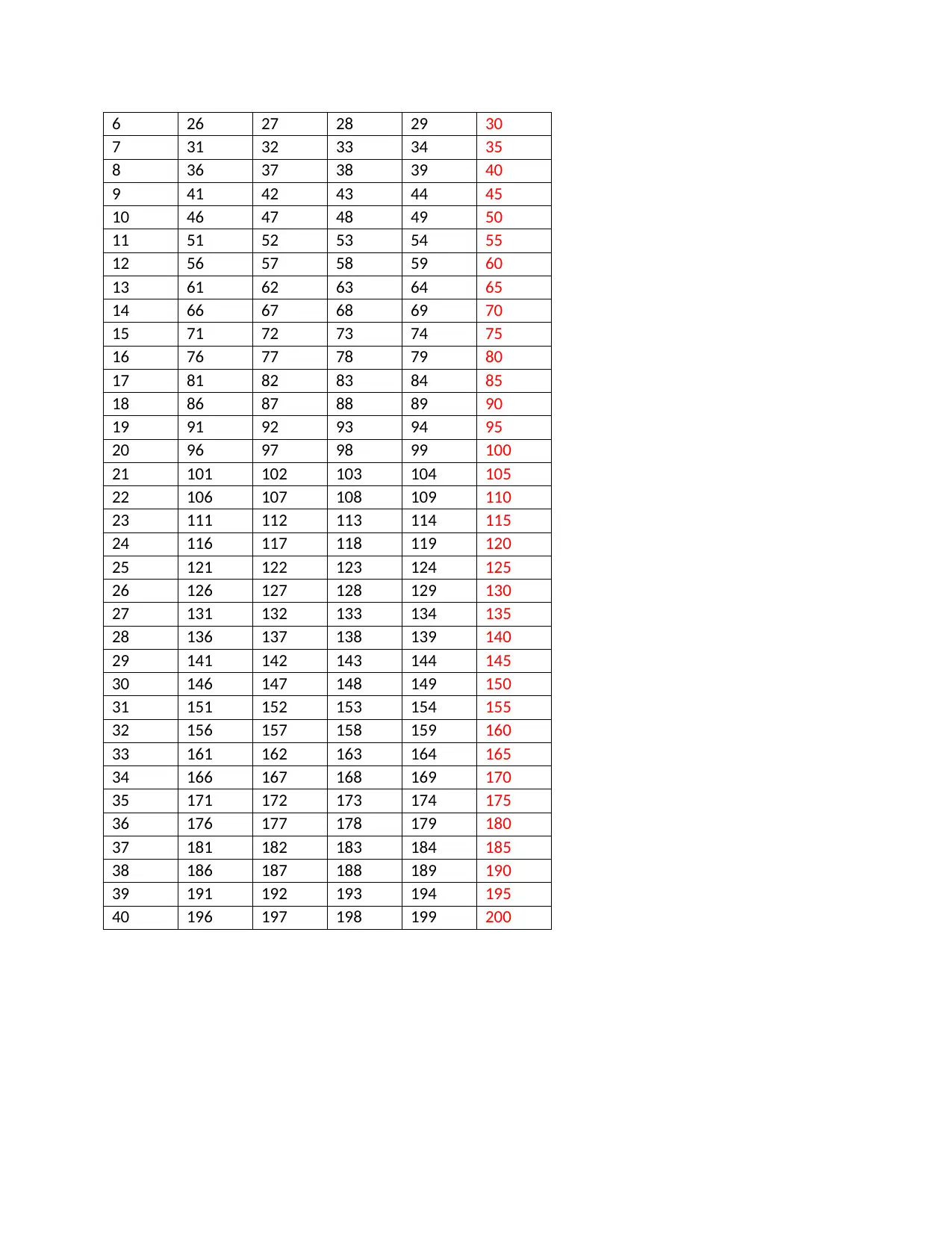
6 26 27 28 29 30
7 31 32 33 34 35
8 36 37 38 39 40
9 41 42 43 44 45
10 46 47 48 49 50
11 51 52 53 54 55
12 56 57 58 59 60
13 61 62 63 64 65
14 66 67 68 69 70
15 71 72 73 74 75
16 76 77 78 79 80
17 81 82 83 84 85
18 86 87 88 89 90
19 91 92 93 94 95
20 96 97 98 99 100
21 101 102 103 104 105
22 106 107 108 109 110
23 111 112 113 114 115
24 116 117 118 119 120
25 121 122 123 124 125
26 126 127 128 129 130
27 131 132 133 134 135
28 136 137 138 139 140
29 141 142 143 144 145
30 146 147 148 149 150
31 151 152 153 154 155
32 156 157 158 159 160
33 161 162 163 164 165
34 166 167 168 169 170
35 171 172 173 174 175
36 176 177 178 179 180
37 181 182 183 184 185
38 186 187 188 189 190
39 191 192 193 194 195
40 196 197 198 199 200
7 31 32 33 34 35
8 36 37 38 39 40
9 41 42 43 44 45
10 46 47 48 49 50
11 51 52 53 54 55
12 56 57 58 59 60
13 61 62 63 64 65
14 66 67 68 69 70
15 71 72 73 74 75
16 76 77 78 79 80
17 81 82 83 84 85
18 86 87 88 89 90
19 91 92 93 94 95
20 96 97 98 99 100
21 101 102 103 104 105
22 106 107 108 109 110
23 111 112 113 114 115
24 116 117 118 119 120
25 121 122 123 124 125
26 126 127 128 129 130
27 131 132 133 134 135
28 136 137 138 139 140
29 141 142 143 144 145
30 146 147 148 149 150
31 151 152 153 154 155
32 156 157 158 159 160
33 161 162 163 164 165
34 166 167 168 169 170
35 171 172 173 174 175
36 176 177 178 179 180
37 181 182 183 184 185
38 186 187 188 189 190
39 191 192 193 194 195
40 196 197 198 199 200
⊘ This is a preview!⊘
Do you want full access?
Subscribe today to unlock all pages.

Trusted by 1+ million students worldwide
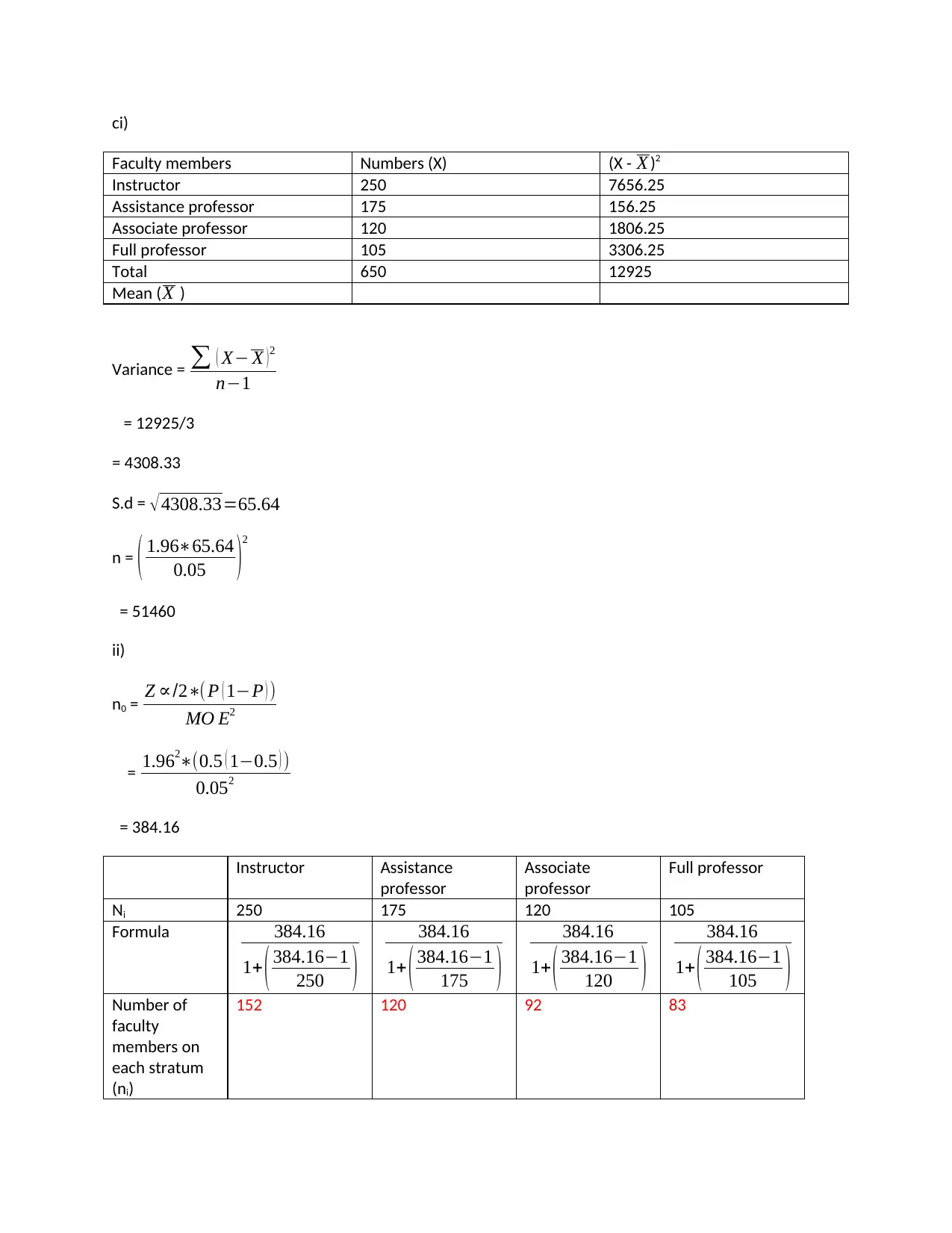
ci)
Faculty members Numbers (X) (X - X )2
Instructor 250 7656.25
Assistance professor 175 156.25
Associate professor 120 1806.25
Full professor 105 3306.25
Total 650 12925
Mean ( X )
Variance = ∑ ( X− X )2
n−1
= 12925/3
= 4308.33
S.d = √4308.33=65.64
n = ( 1.96∗65.64
0.05 )
2
= 51460
ii)
n0 = Z ∝/2∗( P ( 1−P ) )
MO E2
= 1.962∗(0.5 ( 1−0.5 ) )
0.052
= 384.16
Instructor Assistance
professor
Associate
professor
Full professor
Ni 250 175 120 105
Formula 384.16
1+ ( 384.16−1
250 )
384.16
1+ ( 384.16−1
175 )
384.16
1+ ( 384.16−1
120 )
384.16
1+ ( 384.16−1
105 )
Number of
faculty
members on
each stratum
(ni)
152 120 92 83
Faculty members Numbers (X) (X - X )2
Instructor 250 7656.25
Assistance professor 175 156.25
Associate professor 120 1806.25
Full professor 105 3306.25
Total 650 12925
Mean ( X )
Variance = ∑ ( X− X )2
n−1
= 12925/3
= 4308.33
S.d = √4308.33=65.64
n = ( 1.96∗65.64
0.05 )
2
= 51460
ii)
n0 = Z ∝/2∗( P ( 1−P ) )
MO E2
= 1.962∗(0.5 ( 1−0.5 ) )
0.052
= 384.16
Instructor Assistance
professor
Associate
professor
Full professor
Ni 250 175 120 105
Formula 384.16
1+ ( 384.16−1
250 )
384.16
1+ ( 384.16−1
175 )
384.16
1+ ( 384.16−1
120 )
384.16
1+ ( 384.16−1
105 )
Number of
faculty
members on
each stratum
(ni)
152 120 92 83
Paraphrase This Document
Need a fresh take? Get an instant paraphrase of this document with our AI Paraphraser
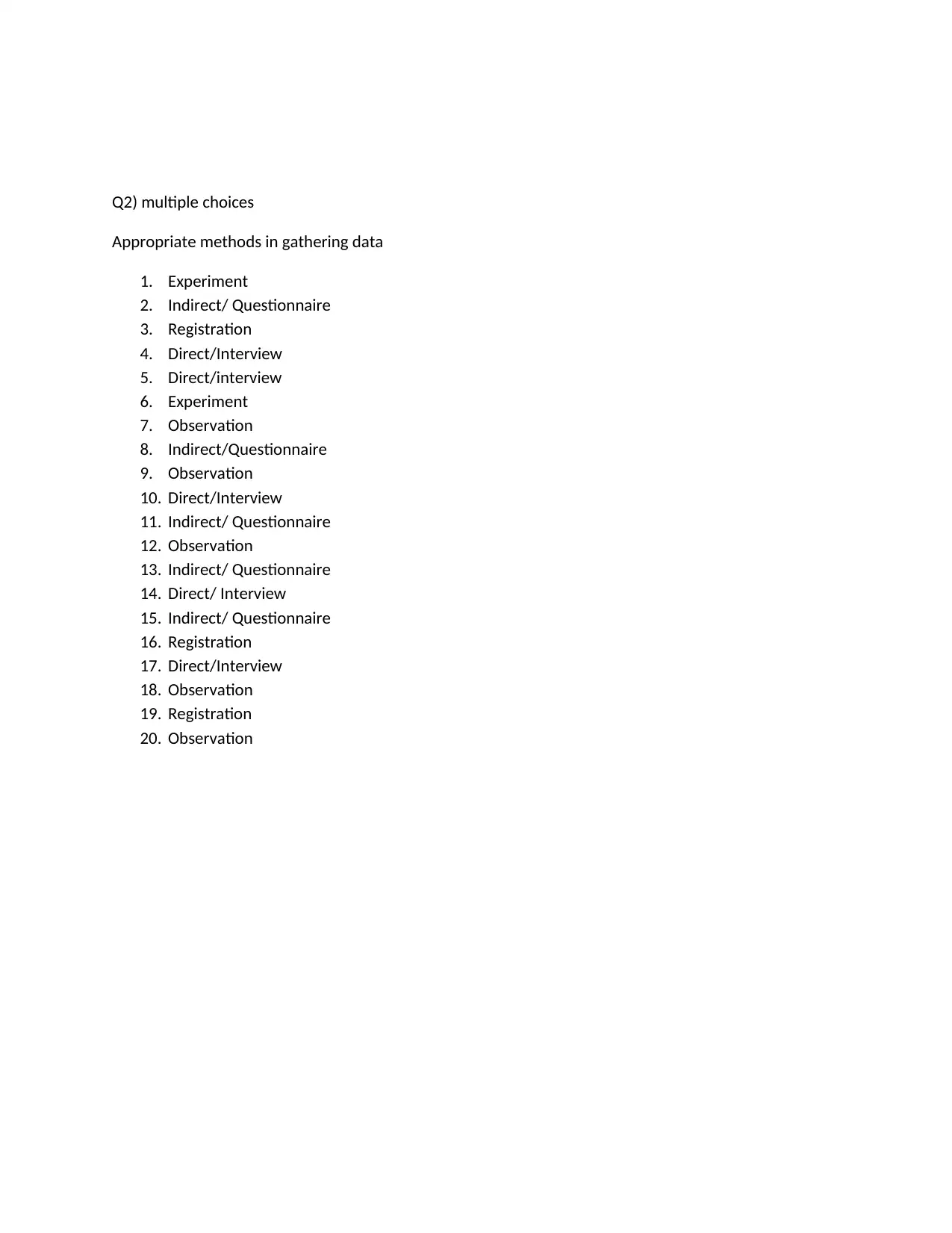
Q2) multiple choices
Appropriate methods in gathering data
1. Experiment
2. Indirect/ Questionnaire
3. Registration
4. Direct/Interview
5. Direct/interview
6. Experiment
7. Observation
8. Indirect/Questionnaire
9. Observation
10. Direct/Interview
11. Indirect/ Questionnaire
12. Observation
13. Indirect/ Questionnaire
14. Direct/ Interview
15. Indirect/ Questionnaire
16. Registration
17. Direct/Interview
18. Observation
19. Registration
20. Observation
Appropriate methods in gathering data
1. Experiment
2. Indirect/ Questionnaire
3. Registration
4. Direct/Interview
5. Direct/interview
6. Experiment
7. Observation
8. Indirect/Questionnaire
9. Observation
10. Direct/Interview
11. Indirect/ Questionnaire
12. Observation
13. Indirect/ Questionnaire
14. Direct/ Interview
15. Indirect/ Questionnaire
16. Registration
17. Direct/Interview
18. Observation
19. Registration
20. Observation
1 out of 5
Related Documents
Your All-in-One AI-Powered Toolkit for Academic Success.
+13062052269
info@desklib.com
Available 24*7 on WhatsApp / Email
![[object Object]](/_next/static/media/star-bottom.7253800d.svg)
Unlock your academic potential
© 2024 | Zucol Services PVT LTD | All rights reserved.




